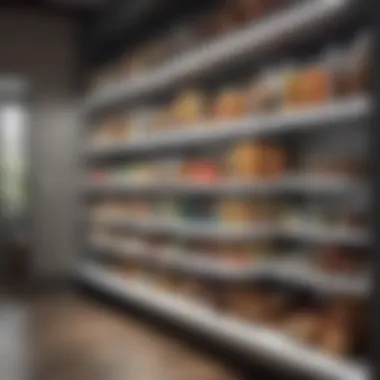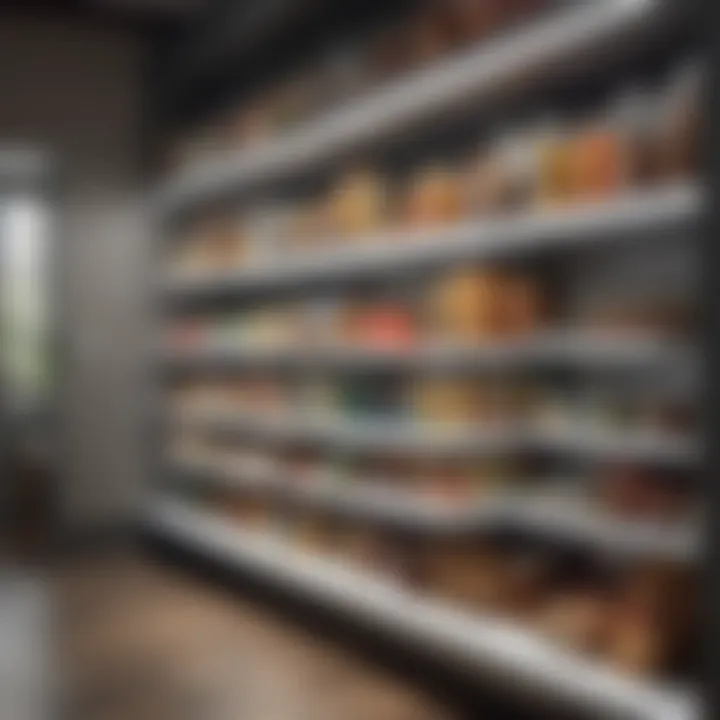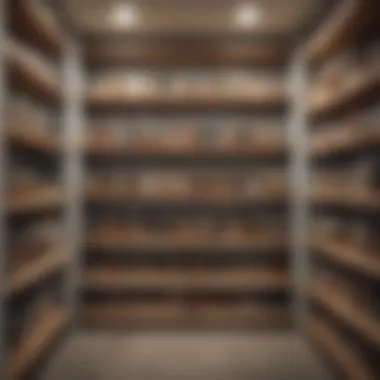Efficient Walk-in Pantry Shelving Solutions


Intro
Optimizing walk-in pantry shelving serves a crucial role in enhancing both functionality and aesthetics in the kitchen. Many homeowners overlook this aspect of design despite its profound impact on everyday life. A well-organized pantry not only elevates cooking experiences but also reflects personal style. The importance of efficient pantry shelving cannot be underestimated; it facilitates easier access to ingredients, improves visibility of items, and ultimately contributes to reduced food waste.
Effective organization within the pantry can transform how one interacts with food. With various shelving options available and the introduction of smart technology, there are countless ways to elevate a pantry’s functionality. The following sections will present practical strategies and design considerations to achieve a well-optimized pantry, focusing on current trends, color palettes, and technology integration.
Design Inspiration
Current Trends in Interior Design
The design of a walk-in pantry is influenced by broader trends in interior design. Minimalism continues to dominate, emphasizing simplicity and clean lines. Open shelving, for example, encourages showcasing ingredients and can create an inviting atmosphere. This trend promotes accessibility, making it easier to view available items.
Sustainable materials also have a significant presence in modern pantry design. Reclaimed wood or bamboo are popular choices that bring warmth and character to the space. These materials not only align with eco-friendly practices but also create a visually appealing contrast with contemporary finishes.
Color Schemes and Palette Ideas
Choosing the right colors for a pantry can enhance its overall feel. Light, neutral tones create an airy environment and make spaces look larger. Whites, creams, and soft pastels can be combined with bolder accents to provide a sense of personality. For example, a soft green or blue for the walls can evoke a calm and refreshing effect.
On the other hand, darker hues such as navy or charcoal can instill a sense of sophistication. When paired with metallic finishes, these colors can create a luxurious ambiance.
Key Considerations for Color Choices:
- Functionality: Light colors can help to brighten small spaces.
- Mood Creation: Different shades can evoke distinct feelings.
- Integration with Kitchen Design: Ensure continuity between the pantry and adjoining spaces.
For homeowners, selecting a color scheme is not only about aesthetics. It reflects personal preferences and can influence the overall experience in the kitchen.
"A well-designed pantry is a perfect balance between functionality and style, serving the needs of the home while reflecting the homeowner's personality."
Technology Integration
In today’s world, integrating modern technology into pantry design has become increasingly popular. Smart shelves that can weigh items provide valuable insights into inventory levels. Additionally, apps that track pantry contents can help in meal planning and grocery shopping.
The introduction of lighting systems that activate when a pantry door opens also enhances usability. Proper lighting ensures every ingredient is visible, minimizing the time spent searching for items.
Prologue to Walk-in Pantries
The walk-in pantry is an essential element in modern home design. It serves not only as an area for storing food but also as a space that enhances the overall functionality of the kitchen. A well-organized pantry can significantly contribute to a streamlined cooking experience. This section will provide clarity on what constitutes a walk-in pantry, its purpose, and the benefits that come with integrating such a feature in a home.
Definition and Purpose
A walk-in pantry is typically a separate room or a designated area within a kitchen that allows for extensive storage options. Unlike traditional pantries with limited shelf space, a walk-in pantry can house various items, from bulk foods to small kitchen appliances. The purpose of this additional space is not just to store food, but also to allow for better organization. Homeowners can easily categorize and access items according to their needs. The ability to step into a pantry and see everything at a glance reduces stress during meal preparation. It makes grocery shopping more efficient as you can determine what you have and what you need without opening multiple cabinets.
Benefits of a Walk-in Pantry
A well-implemented walk-in pantry can offer several advantages:
- Increased Storage: Walk-in pantries often come with adjustable shelving options, allowing for optimal use of space. Homeowners can store a wider variety of items, including non-perishables, canned goods, and small kitchen appliances.
- Organizational Ease: Large spaces allow for categorization, so things like spices, snacks, and baking supplies can be grouped together. This not only makes finding products easier but also speeds up cooking and meal prep.
- Flexibility for Design: A walk-in pantry can be tailored to fit personal style and preferences. Homeowners have the freedom to choose shelves, containers, and layouts that reflect their taste while ensuring practicality.
- Enhanced Accessibility: With a walk-in setup, individuals can easily retrieve items without the need to pull out one container or box after another. Layers of organization mean that everything remains within reach.
- Preservation of Kitchen Space: Keeping a walk-in pantry allows the main kitchen area to remain uncluttered and functional. This results in a more visually appealing kitchen while providing a dedicated area for larger items and bulk buys.
Walk-in pantries, therefore, offer a practical solution to the challenges faced in kitchen storage. Their benefits make them an attractive option for homeowners looking to improve the efficiency of their living spaces.
Understanding Shelving Options
Understanding shelving options is central to optimizing the functionality and visual appeal of walk-in pantries. The choice of shelving can significantly influence how effectively space is utilized and how accessible pantry items are. It is essential to consider various materials and systems to find the perfect match for individual needs, preferences, and style. Each shelving option has unique attributes and implications on organization and maintenance. Thus, careful selection plays a critical role in the overall effectiveness of the pantry design.
Types of Shelving Materials
When it comes to shelving materials, several types stand out, each with its own merits and drawbacks that impact their suitability for walk-in pantries.
Wood
Wood is a classic and widely sought-after material for shelving in pantries. Its natural aesthetic can enhance the warmth of the space while providing durability. One key characteristic of wood is its ability to bear heavy loads, making it suitable for storing a substantial amount of items. The unique feature of wood shelves is their versatility in design, allowing for custom finishes, shapes, and sizes that align with personal tastes. However, wood requires regular maintenance, may be susceptible to moisture damage, and can be a more expensive option compared to alternatives.


Metal
Metal shelves are another popular choice due to their strength and modern appearance. They often come in galvanized or painted finishes, providing various options to match a pantry's overall style. The primary advantage of metal is its stability under weight load, making it particularly beneficial for heavier storage items. However, metal can be prone to rust if not properly treated, especially in humid environments. Its industrial look may not suit all aesthetics, limiting its appeal to those who appreciate a contemporary vibe.
Wire
Wire shelving is known for its lightweight design and air circulation benefits, making it a practical choice for walk-in pantries. The open design allows for visibility and easy access to stored items. One distinctive feature of wire shelving is its adaptability; many systems come with adjustable heights and compatibility with various accessories. However, wire shelves can struggle with holding very small items, as they might fall through the gaps, requiring careful organization.
Glass
Glass shelving offers a sleek and modern aesthetic, allowing light to pass through and creating an illusion of space. It can showcase items beautifully, enhancing decor value. The unique characteristic of glass shelves is their ability to maintain cleanliness and provide a high-end look. On the downside, glass can be more fragile than other materials and might not withstand heavy weights, making it less practical for heavy items.
Comparative Analysis of Shelving Systems
Different shelving systems provide various functionalities that meet specific storage needs. Choosing the right system can determine how effectively space is used and how organized the pantry remains over time.
Adjustable Shelves
Adjustable shelves are increasingly popular due to their flexibility. This system allows homeowners to change shelf heights according to the size of the items stored. A significant advantage is the ability to adapt to changing storage needs over time. However, these shelves may lack the stability of fixed shelves, potentially affecting heavier items' placement.
Fixed Shelves
Fixed shelves provide a sturdy and reliable option for those who prefer a consistent layout in their pantries. Their strong construction supports heavier objects well, making them perfect for item storage that does not vary. One disadvantage, though, is the inability to adjust the height, which limits adaptability for new storage configurations.
Pull-out Shelves
Pull-out shelves are a modern solution offered in many designs. They are designed to enhance accessibility, allowing users to easily reach items at the back without hassle. The feature of these shelves is that they slide out like drawers, improving usability. A drawback may be the installation complexity and potential for mechanical malfunctions over time.
In summary, the choice of shelving material and system has a significant impact on the functionality and aesthetics of a walk-in pantry. Understanding the strengths and weaknesses of each option can lead to more informed decisions, ultimately enhancing the organization and efficiency of the space.
Design Considerations for Pantry Shelving
When designing a pantry, the shelving configuration plays a critical role in usability and functionality. It impacts how easily users access items as well as the overall aesthetic of the pantry. Prioritizing effective design considerations enables homeowners to maximize their storage capabilities and create a pantry that is both efficient and visually appealing.
Space Utilization
Efficient space utilization is at the heart of any successful pantry design. Understanding the measurements and layout of the pantry is essential to making informed shelving decisions. Ensure that the shelves are not only appropriately sized but also positioned for easy access.
Consider adjustable shelving systems. These can be modified in height according to specific needs. Items like canned goods might require deeper shelves, while spices can be arranged on shallower ones. This flexibility allows homeowners to adapt their storage to changing needs.
Utilizing vertical space is also vital. Installing shelves that reach up to the ceiling can significantly enhance storage capacity. However, it is important to remember that items stored higher up may require a steps stool to access. Balancing height with accessibility is a key consideration.
Effective use of horizontal and vertical spaces combined can yield a vastly improved pantry layout.
Aesthetics and Style
A well-designed pantry not only fulfills practical needs but also complements the home’s overall style. Selecting materials and colors that harmonize with the kitchen can solidify the pantry as part of the living space rather than a utilitarian area.
Opt for shelving materials that align with your aesthetic. For instance, wooden shelves can evoke a warm, rustic feel, while metal shelves impart a modern, sleek look. Color choices become important as well; light colors enhance the sense of space, whereas darker shades can introduce an intimate quality. Additionally, integrating decorative elements, such as matching containers or decorative boxes, can contribute positively to the visual appeal.
Also, consider incorporating open shelving. This design not only displays selected items in a visually pleasing manner but also encourages organization, making it easy to see what is available.
Lighting Solutions
Proper lighting is a fundamental aspect that should not be overlooked in pantry design. Proper illumination enhances both the functionality and ambiance of the space. Without adequate lighting, even the best-organized pantry can feel cluttered and uninviting.
It is advisable to explore various lighting options. Task lighting, such as LED strip lights under shelves, ensures that items are well-lit. It helps in locating ingredients quickly and minimizes the risk of accidents when reaching for items in low-light conditions. Additionally, using natural light, if possible, through windows or skylights can enhance the pantry's brightness.
Also, consider utilizing dimmable lights. This way, the brightness can be adjusted according to the need, ensuring functionality while creating a comfortable atmosphere.
In summary, considerations in design are crucial for optimizing pantry shelving. From thoughtful space utilization to stylistic coherence and effective lighting, each element contributes to enhancing usability and aesthetic appeal. The interplay of these factors determines the overall success of a pantry design.
Maximizing Storage Capacity


Maximizing storage capacity is a fundamental aspect of walk-in pantry design. An optimally organized pantry not only enhances functionality but also improves accessibility to your items. Homeowners and design enthusiasts realize the importance of utilizing every inch of available space. Efficient storage solutions can simplify meal preparation and keep your pantry neat. Understanding how to maximize storage can also save time and reduce food waste, as items are easier to find and access.
Vertical Space Optimization
Vertical space often remains underused in many pantries. By utilizing this area effectively, you can significantly increase storage capacity. Installing shelves that extend from the floor to the ceiling is one strategy. This approach allows you to store larger items on lower shelves while keeping frequently used ingredients within arm's reach.
Adjustable shelving systems offer flexibility; you can alter the height of the shelves according to your needs. Using stackable bins can also help in maximizing vertical space. These bins allow for the storage of smaller items in a compact manner. In addition, consider using hooks or magnetic strips to hang lightweight items. This method keeps the pantry organized and frees up shelf space for larger containers or boxes.
Utilizing Corners and Nooks
Corners and nooks are often overlooked in pantry design. However, these areas can provide valuable extra storage if utilized properly. Installing corner shelves or tiered storage can make previously unusable space functional. Lazy Susans are another great option for corner spaces, allowing easy access to items stored in these hard-to-reach areas.
Additionally, think about narrow shelving units that can fit into small nooks. These units can store spices, oils, or cooking utensils. It’s also wise to use baskets or bins in these spaces, as they can hold various items together, making it easier to pull everything out at once.
"Efficient use of corners and nooks can transform your pantry from a cluttered space into a well-organized haven."
Incorporating Multi-Purpose Shelving
Multi-purpose shelving can significantly enhance storage capacity in walk-in pantries. This concept involves using shelves that serve more than one function. For example, open shelving not only holds grocery items but can also showcase decorative jars or cookbooks. This dual-use reduces clutter and brings an aesthetic appeal to your pantry.
Another effective method is to integrate pull-out baskets into shelving systems. These baskets can be used for quick access to snacks or kitchen essentials. They prevent items from accumulating and keep your pantry organized.
Incorporating tiered racks for spices or canned goods can maximize vertical and horizontal space. By creating a designated area for each category, you keep everything in sight and easy to manage. This organization strategy ultimately simplifies your cooking process by allowing you to find the necessary ingredients quickly.
Implementing these strategies not only optimizes space but also adds functionality to your walk-in pantry.
Organizational Strategies
In the context of optimizing walk-in pantry shelving, organizational strategies are crucial. Proper organization not only enhances the aesthetic appeal of the pantry but also significantly improves functionality. An organized pantry makes accessing food items easier and reduces waste by ensuring that nothing is forgotten at the back of the shelves. This results in efficiency during meal preparation and grocery shopping. Furthermore, an organized space can make it easier to maintain inventory, leading to better decisions about restocking and reducing unnecessary purchases.
Implementing effective organizational strategies also takes into account the specific needs of the household. Tailoring the setup to the preferences and routines of the users can lead to a more satisfactory experience. It invites creativity and encourages experimentation with different layout setups, ultimately creating a personalized space that meets individual requirements.
Categorizing Pantry Items
Categorizing pantry items is an essential first step in maintaining a well-organized space. By grouping similar items together, the pantry becomes visually coherent, allowing users to quickly locate what they need. Consider dividing pantry contents into categories such as dry goods, canned foods, baking supplies, snacks, and beverages.
Benefits of Categorization:
- Quick Access: Users can find items quickly without digging through mixed contents.
- Reduced Waste: Identifying similar items minimizes the risk of buying duplicates.
- Streamlined Meal Prep: Categories make it easier to plan meals based on accessible ingredients.
Labeling Techniques
Labeling techniques are an important aspect of pantry organization. Clear labels help reinforce the categorized system and promote easy retrieval. Labels should be legible and strategically placed for instant recognition.
- Label Types:
- Printed Labels: Use a label maker for a professional look.
- Handwritten Labels: Add a personal touch and creativity with your own handwriting.
- Color-Coded Labels: Assign colors for different categories for immediate visual association.
Proper labeling not only supports organization but can also enhance the overall aesthetic of the pantry. Consistent labeling encourages all household members to return items to their rightful place, sustaining the level of organization.
Rotation and Accessibility
Another significant organizational strategy revolves around the rotation and accessibility of items. This involves placing older products in front and newer items in the back. Such a system is particularly important for perishable goods, keeping expiration dates in check and reducing the likelihood of waste.
Accessibility Considerations:
- Frequent Use Items: Store snacks or cooking staples at eye level or in easily reachable locations.
- Less Frequent Items: Position these at higher or lower levels.
Varying shelf heights within the pantry can enhance accessibility. This allows items of different sizes to be stored efficiently. Pull-out shelves or bins can also provide better access to items situated at the back.
An effectively organized pantry serves not just as storage but as a functional space that reflects the household's lifestyle.


Incorporating Technology
In today’s fast-paced world, technology is not just a luxury but also a vital aspect of efficiency, even in something as practical as pantry organization. The incorporation of technology into walk-in pantry design enhances usability and can transform an ordinary space into a highly functional and organized area. Homeowners and design enthusiasts should consider various technological solutions that simplify inventory management and streamline day-to-day operations in the pantry.
The integration of smart systems offers several benefits. First, it can lead to better inventory control. With the right tools, users can track what they have on hand, preventing overbuying or wastage. Additionally, technological solutions improve accessibility and overall experience in the pantry, making it more enjoyable to navigate and utilize this often-overlooked space.
Smart Pantry Solutions
Smart pantry solutions involve devices and systems designed to automate tasks and enhance organization. These may range from smart shelves that can detect item quantities to sensors that alert users when staples are running low. Such technologies not only save time but also reduce the mental load of keeping track of pantry supplies.
For instance, some people may install smart cameras within their pantry to monitor contents remotely via mobile apps. This feature can be particularly useful while shopping, eliminating guesswork about pantry stock.
Moreover, smart shelving options exist that allow users to adjust shelf heights or widths according to their needs, accommodating various sizes of food containers and storage bins. This adaptability can make a significant difference in optimizing the space effectively.
Inventory Management Tools
Inventory management tools are key components when incorporating technology into pantry shelving. These tools can help homeowners maintain a well-organized pantry by keeping track of food items and their expiration dates.
Several applications are available that allow users to input items manually or scan barcodes for easy tracking. Besides tracking items, these apps can suggest recipes based on available ingredients or notify individuals when items are about to expire, thus encouraging timely use.
Some popular inventory management tools include:
- Pantry Manager: This app lets you catalog your items, add expiration dates, and generate shopping lists based on what you have.
- Out of Milk: A sophisticated tool for grocery lists and pantry inventory that syncs across devices, making shopping easier.
- NoExpiration: This app helps track perishables and ensures that nothing goes to waste.
By adopting these technologies, homeowners can achieve a higher level of pantry organization and efficiency, aligning with modern day needs.
Overall, integrating technology into walk-in pantry design is not merely about adding gadgets. It is about creating an environment that fosters ease, organization, and functionality. By utilizing smart solutions and inventory management, individuals can turn their walk-in pantry into a model of efficiency that meets their lifestyle requirements.
Maintenance and Upkeep
Maintaining a walk-in pantry is essential for ensuring it remains organized and functional over time. Regular maintenance not only preserves the aesthetic aspects of the space but also enhances its usability. When pantry items accumulate dirt, clutter, or even pests, the overall efficiency of the pantry diminishes. Thus, taking care of the pantry encourages a healthy living environment and makes the food items easily accessible.
A well-maintained pantry allows for better visibility of items, which simplifies meal preparation and inventory management. In a space where organization is key, it is wise to establish a cleaning routine. The benefits of upkeep extend beyond mere cleanliness; they contribute to a more enjoyable cooking experience.
Regular Cleaning Practices
Cleaning practices should form the backbone of any maintenance routine. A thorough cleaning can include several steps:
- Shelf Dusting: Start by removing all items from the shelves. Use a cloth or vacuum to eliminate dust and debris. This helps create a fresh start.
- Surface Wiping: After dusting, wipe down shelves with a mild detergent that is safe for the material. For instance, glass shelves need careful handling to avoid scratches.
- Floor Care: Don’t forget the floors. Sweep and mop the pantry floor regularly to keep dirt at bay. If there are spills, it’s important to address them immediately to prevent mold growth.
- Expiration Checks: Regularly review food items for expiration. Discard expired items promptly to avoid confusion and maintain freshness.
Regular cleaning promotes not just visual appeal but also health and functionality in your pantry.
Assessing and Adapting Shelving Solutions
Adapting your shelving solutions is critical for optimal pantry use. As items are added or removed, the needs of the pantry may change, requiring reevaluation of the shelving setup. Here are key considerations for assessing your shelving:
- Condition Check: Inspect shelves for wear and tear. Look for signs of damage or sagging, which can compromise their integrity.
- Reorganizing: If certain items are used more frequently, consider moving them to accessible shelves. Utilizing higher shelves for rarely used items maximizes space.
- Adjustability: If your shelving system is adjustable, do not hesitate to modify the height of shelves. This allows you to accommodate larger items or more extensive collections of particular goods.
- Flexibility: Think about multi-functional shelving units. They can adapt to changing pantry items, ensuring consistent organization.
Keeping these aspects in mind will help maintain an effective layout, fostering a scenario where everything has its rightful place, ultimately making your cooking and hosting experiences more pleasant.
End
The conclusion of this article serves to emphasize the critical importance of optimizing walk-in pantry shelving. In recent years, the need for efficient storage solutions has become increasingly relevant, especially for homeowners who value organization and accessibility. A well-structured pantry can lead to significant time savings during meal prep and grocery shopping while also enhancing the overall aesthetics of a home.
Summarizing Key Points
Throughout this article, several essential aspects have been highlighted regarding the effective use of walk-in pantry shelving.
- Understanding Shelving Options: Knowledge of different materials such as wood, metal, and wire empowers users to make informed choices based on durability, cost, and appearance.
- Design Considerations: Thoughtful layout and aesthetically pleasing designs can transform the pantry from merely functional to a visually appealing part of the home.
- Maximizing Storage Capacity: Efficient use of vertical space and corners can lead to an increase in storage solutions.
- Organizational Strategies: Employing categorization and labeling techniques promotes easy access to pantry items and ensures inventory rotation.
- Technology Integration: Smart solutions, like inventory management tools, can modernize pantries, making them more efficient.
- Maintenance Regimen: Regular cleaning and assessment of shelving can prolong the life of pantry units and keep the space in top shape.
By considering these key points, homeowners can create a pantry that not only meets their practical needs but also suits their personal style.
Future Trends in Pantry Design
As we look ahead, it is clear that the design of walk-in pantries will continue to evolve with changing homeowner preferences and advances in technology. Some predicted trends include:
- Sustainable Materials: With an increasing focus on sustainability, many will opt for eco-friendly shelving options. This shift will likely include repurposed wood and aluminum, highlighting environmental stewardship in home design.
- Smart Technology: As smart home integration grows, pantries with automated inventory systems and smart labeling will become more common. This will enhance convenience for users by streamlining everyday processes.
- Modular Shelving: The rise of modular storage solutions will allow homeowners to customize their pantries more flexibly. This would cater to diverse storage requirements and changing lifestyles.
The future of pantry design promises to be stylish, functional, and innovative. Embracing these trends will not only improve organization but also align with the modern approach to home living and convenience.



